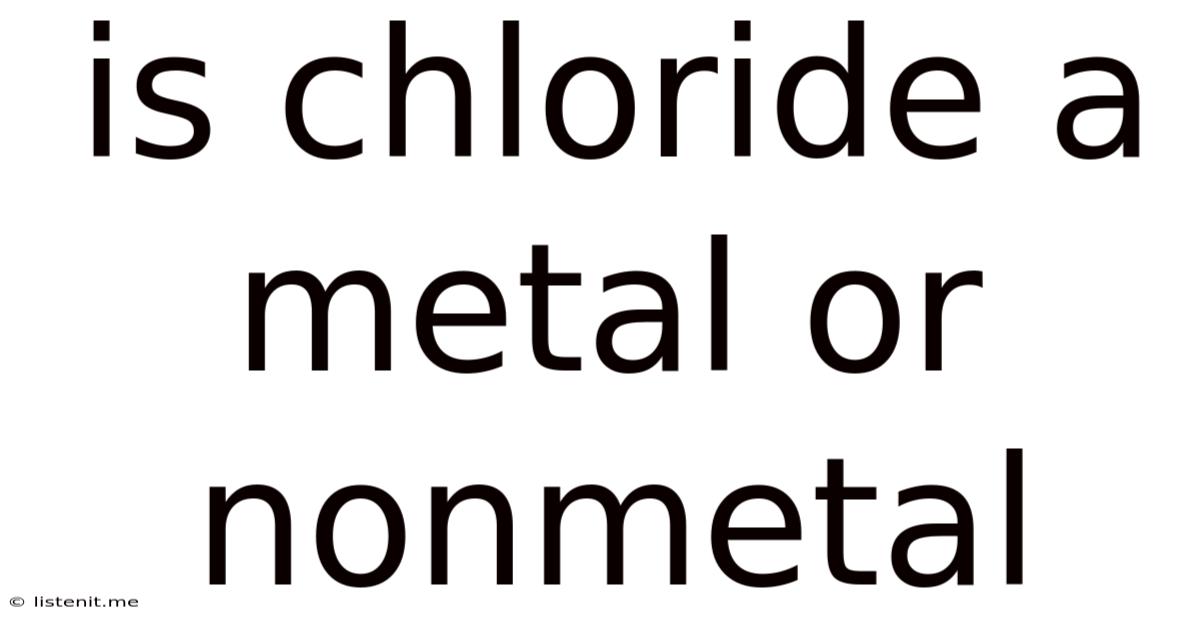Is Chloride A Metal Or Nonmetal
listenit
May 10, 2025 · 4 min read

Table of Contents
Is Chloride a Metal or Nonmetal? Understanding the Nature of Chloride Ions
Determining whether chloride is a metal or a nonmetal requires understanding its position within the periodic table and its chemical properties. While the term "chloride" often refers to the chloride ion (Cl⁻), it's crucial to first address the element chlorine (Cl) itself before delving into the characteristics of its ionic form.
Chlorine: A Nonmetal with Reactive Properties
Chlorine (Cl), element number 17 on the periodic table, is unequivocally a nonmetal. It resides in Group 17, also known as the halogens, a group known for its highly reactive nonmetallic elements. These elements readily gain an electron to achieve a stable electron configuration, a characteristic hallmark of nonmetals.
Key Properties that Classify Chlorine as a Nonmetal:
-
Electron Configuration: Chlorine has seven valence electrons, meaning it's one electron short of a full outer shell. This tendency to readily gain an electron, rather than lose one, is a key characteristic of nonmetals. Metals, in contrast, tend to lose electrons to achieve stability.
-
Electronegativity: Chlorine possesses a high electronegativity value. Electronegativity measures an atom's ability to attract electrons within a chemical bond. The high electronegativity of chlorine reflects its strong pull on electrons, further solidifying its nonmetallic nature.
-
Physical State and Appearance: At standard temperature and pressure, chlorine exists as a diatomic gas (Cl₂), a yellow-green gas with a pungent and irritating odor. This gaseous state, unlike the solid or liquid states typically associated with metals, is another indicator of its nonmetallic identity.
-
Electrical Conductivity: Chlorine is a poor conductor of electricity, both in its solid and gaseous states. Metals, in contrast, are excellent conductors due to the mobility of their electrons.
-
Chemical Reactivity: Chlorine is extremely reactive, readily forming compounds with many other elements. This reactivity stems from its strong tendency to gain an electron and form stable ionic bonds. This high reactivity is typical of nonmetals.
Chloride Ion (Cl⁻): Still a Nonmetal, but with Altered Properties
When chlorine gains an electron, it forms the chloride ion (Cl⁻). This ion is still fundamentally considered nonmetallic, even though its properties differ from those of neutral chlorine atoms. The crucial point is that the chloride ion retains the core electronic structure defining chlorine as a nonmetal. It merely achieves a stable octet configuration by gaining an electron.
Distinguishing Chloride Ion from its Parent Atom:
The transformation from chlorine atom to chloride ion brings about significant changes in its physical and chemical properties. However, its fundamental nonmetallic character persists.
-
Charge: The chloride ion carries a negative charge (1-), a direct consequence of gaining an electron. This charge influences its interactions with other ions and molecules.
-
Ionic Bonds: Chloride ions predominantly form ionic bonds with positively charged ions (cations), such as sodium (Na⁺) in sodium chloride (NaCl, common table salt). Ionic bonds arise from electrostatic attraction between oppositely charged ions.
-
Solubility: Chloride salts are often soluble in water, meaning they dissolve easily to form aqueous solutions. This solubility depends on the interaction between the chloride ion and water molecules.
-
Reactivity: While chlorine is highly reactive, the chloride ion is considerably less reactive. This decreased reactivity is attributed to the stable electron configuration achieved by gaining an electron.
Applications of Chloride and its Compounds: A Testament to its Importance
The ubiquitous nature of chloride and its compounds highlights their crucial roles in various applications.
Chloride's presence in everyday life:
-
Sodium Chloride (NaCl): Common table salt, indispensable in food preparation and as a preservative. Its role in human physiology is also vital.
-
Polyvinyl Chloride (PVC): A versatile plastic used in pipes, flooring, and other applications. PVC's durability and resistance to chemicals are highly valued.
-
Potassium Chloride (KCl): Used in fertilizers to provide essential potassium for plant growth. It also has medical applications.
-
Calcium Chloride (CaCl₂): A de-icing agent commonly used on roads during winter. It also has applications in food processing and construction.
-
Hydrochloric Acid (HCl): A strong acid used extensively in industrial processes, such as metal cleaning and chemical synthesis. It's also found naturally in the stomach.
Chloride's role in biological systems:
-
Electrolyte Balance: Chloride ions play a crucial role in maintaining the electrolyte balance in the human body, essential for nerve impulse transmission and muscle function.
-
Digestion: Hydrochloric acid in the stomach contributes to the digestion of food.
Conclusion: Chloride Remains Nonmetallic
To reiterate, chlorine is definitively a nonmetal, and the chloride ion, formed when chlorine gains an electron, retains its fundamental nonmetallic character. While its properties change upon gaining an electron, its core electronic structure, reflecting a nonmetal's tendency to gain electrons, remains unchanged. This fundamental characteristic places both chlorine and the chloride ion firmly within the category of nonmetals. Their extensive applications in diverse fields underscore their importance and further reinforce the understanding of their nonmetallic nature. Understanding the difference between chlorine and the chloride ion, while recognizing their shared nonmetallic nature, is crucial for appreciating their significant roles in chemistry, biology, and industry.
Latest Posts
Latest Posts
-
Transfer Of Heat Through Electromagnetic Waves
May 10, 2025
-
How Many Protons Neutrons And Electrons In Calcium
May 10, 2025
-
What Is The Greatest Common Factor Of 36 And 20
May 10, 2025
-
Alka Seltzer And Water Chemical Reaction Formula
May 10, 2025
-
How Many Stomachs Do A Camel Have
May 10, 2025
Related Post
Thank you for visiting our website which covers about Is Chloride A Metal Or Nonmetal . We hope the information provided has been useful to you. Feel free to contact us if you have any questions or need further assistance. See you next time and don't miss to bookmark.